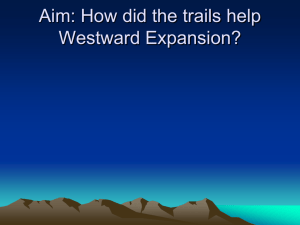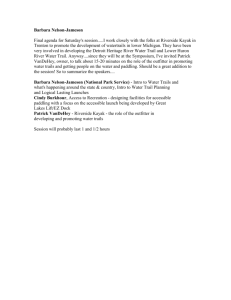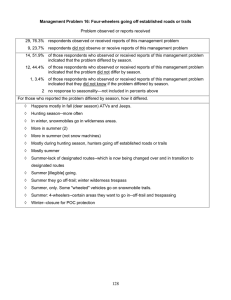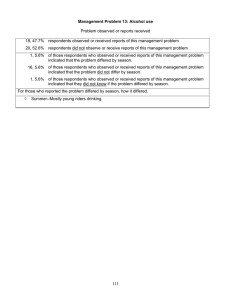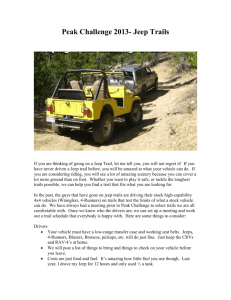Management Problem 6: Conflicts with other four-wheelers on the trails
advertisement
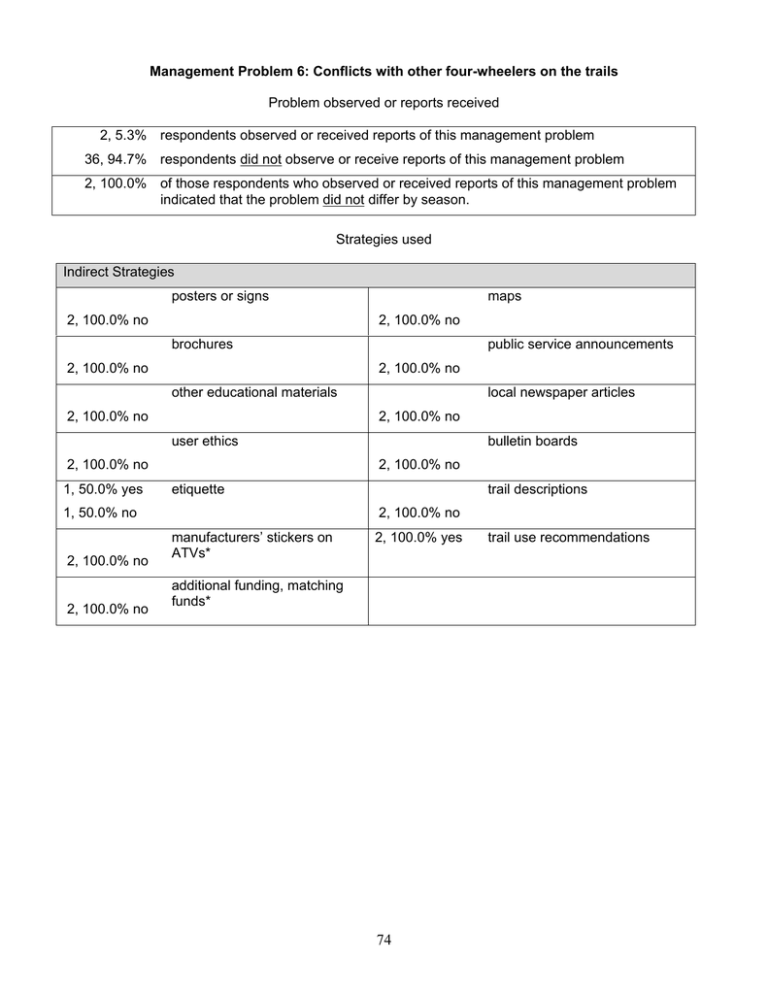
Management Problem 6: Conflicts with other four-wheelers on the trails Problem observed or reports received 2, 5.3% respondents observed or received reports of this management problem 36, 94.7% respondents did not observe or receive reports of this management problem 2, 100.0% of those respondents who observed or received reports of this management problem indicated that the problem did not differ by season. Strategies used Indirect Strategies posters or signs 2, 100.0% no maps 2, 100.0% no brochures 2, 100.0% no public service announcements 2, 100.0% no other educational materials 2, 100.0% no local newspaper articles 2, 100.0% no user ethics 2, 100.0% no 1, 50.0% yes 2, 100.0% no etiquette 1, 50.0% no 2, 100.0% no 2, 100.0% no bulletin boards trail descriptions 2, 100.0% no manufacturers’ stickers on ATVs* 2, 100.0% yes additional funding, matching funds* 74 trail use recommendations Management Problem 6: Conflicts with other four-wheelers on the trails Direct Strategies provisions for special use permits close or limit use 2, 100.0% no 2, 100.0% no 2, 100.0% no 2, 100.0% no non-issuance of outfitter, guide, or event permits organized events to do trail maintenance relocate or designate OHV trails 2, 100.0% no 1, 50.0% yes 1, 50.0% no users ride in dispersed patterns 2, 100.0% no 1, 50.0% yes separate trails 1, 50.0% no seasonal closures 2, 100.0% no 2, 100.0% no law enforcement separate user groups 2, 100.0% no make repairs as soon as located* alternate between user groups 2, 100.0% no pick up litter* 2, 100.0% no 2, 100.0% no voluntary sound tests* 2, 100.0% no 75 use OHV trail crews to maintain trails* Management Problem 6: Conflicts with other four-wheelers on the trails Resource Hardening Strategies Specify a maximum grade on trails? 2, 100.0% no 2, 100.0% no artificial tread (e.g., geofabric with sand and gravel, concrete blocks) What percent? n/a Specify a minimum grade? lengthened trails to disperse riders 2, 100.0% no 2, 100.0% no What percent? n/a 2, 100.0% no drain dips (meaning a reversal of grade) 2, 100.0% no flexible water bars 2, 100.0% no 2, 100.0% no 2, 100.0% no designated campsites 2, 100.0% no for events, restricted to one direction (e.g., uphill or downhill)* trail design: limit long straightaways/use all single track/ use natural obstacles* barricades, barriers* 2, 100.0% no 2, 100.0% no rolling dips, dog bones* 2, 100.0% no staging areas with parking facilities 2, 100.0% no 76 general trail maintenance including consistent, mechanized & 3-year plan* overflow parking and staging areas* Management Problem 6: Conflicts with other four-wheelers on the trails Bridge Building/Collaboration Strategies 1, 50.0% yes personal contacts 1, 50.0% yes 1, 50.0% no 1, 50.0% no local OHV club meetings 1, 50.0% yes partner with different groups volunteer patrols 1, 50.0% no 2, 100.0% no meetings with state OHV groups 2, 100.0% no partner with OHV shops 2, 100.0% no adopt-a-trail program 2, 100.0% yes workshops trail safety evaluation form 1, 50.0% yes committees with different groups 2, 100.0% no 2, 100.0% no 2, 100.0% no 1, 50.0% no education, including campfire programs* 1, 50.0% yes 1, 50.0% no working with sheriff’s dept.* joint clean-ups with BLM* 2, 100.0% no 2, 100.0% no mine safety evaluation form* 2, 100.0% no 2, 100.0% no maintain trail with local groups and volunteers 2, 100.0% no find out from users and environmentalists where trails should be* * Strategies added by respondents in response to open-ended questions. 77 help from regional office and state* Management Problem 6: Conflicts with other four-wheelers on the trails Strategies reported “used most often” 1, 50.0% partner with different groups 1, 50.0% law enforcement Strategies reported “most effective” Why “most effective” 1, 50.0% committees with different groups ◊ Group reps. hear concerns from other reps. and return information to their groups-improved communication and understanding and potential group sport benefits. 1,50.0% law enforcement ◊ If we write them a ticket, it tells them that we mean business. 2, 100.0% of those respondents who observed or received reports of this management problem indicated that their strategies did not differ by season. 78

